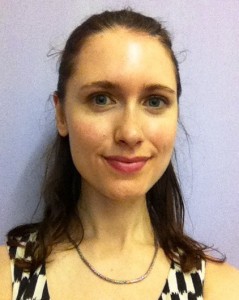
Carla Marschall, PYP coordinator and Middle School curriculum coordinator at Zurich International School
In the previous post, the author gave practical advice on how to start planning for teaching and learning in mathematics so that it leads to conceptual understanding. In this post, she talks about sample learning engagements that lead students to understand mathematical concepts.
Making connections across mathematical concepts
We can support the development of conceptual understanding in mathematics by asking students to make connections between concepts and to justify their ideas. After our school’s session with Professor Cathy Marks Krpan, we explored two ways we can do this: the use of ‘student proofs’ and concept mapping.
Student proofs
In this activity, students are given a mathematical statement (usually an untrue statement) and asked to prove if it is true or not. Students can use words, symbols, or pictures to justify their thinking. By doing this, students are pushed to think how related concepts might help prove their thinking.
Here is an example of a 2nd grade proof for the statement 10-5=7. You can see how students show their understanding of addition in relation to the subtraction problem.
Here is 3rd grade proof example for the statement 25÷5=6. Students showed various levels of conceptual depth. Some showed the inverse relationship between multiplication and division and some relied on skip counting as a strategy to show why the division equation was false.
Concept mapping
Concept maps developed by Joseph Novak provide a way for teachers to see how students visualize connections between mathematical concepts. Different from a brainstorm or mind map, concept maps require students to think hierarchically, i.e. which idea is more/less central to the question asked. Students also write how each idea is connected to another using a verb. Here is a 2nd grade concept map used as a pre-assessment for a weather/climate unit. Some words were provided by the teacher while others were created by the students.
Concept maps work well for students in 1st/2nd grade and up but can also be augmented for Early Years students. Instead of providing words, this strategy can be changed to be purely pictorial. Furthermore, the explanation of how ideas are connected can be done orally by the children and/or scribed by the teacher.
Here is an example of the beginnings of concept mapping with Kindergarten. These students looked for connections across pairs of symbols (a precursor to making connections across concepts). They were required to justify how their symbols “go together”. This group made connections based on straight and curvy lines as opposed to the number represented. Objects with straight lines are at the top while objects with curvy lines are at the bottom of their map.
—
How do you teach your students mathematical concepts?

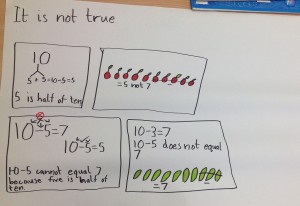
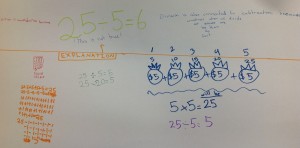
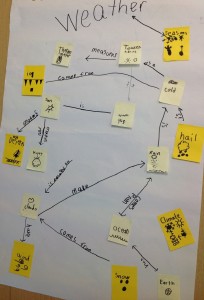
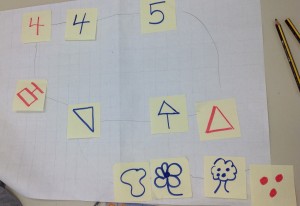
Thank you Carla for a wonderful read and the visuals made it all the more clearer. I help guide 4-5 year old children in China and at the start of the year, just a few weeks ago, we laid out some provocations to help us connect with the children and attain a clear image of them with regards to their current learning stages.
My co-practitioner Tania and I are new to the school and the children as well. One of the things that the school had purchased over the summer was a small wooden cash register with some fake money in it. While we were observing them we noticed that one of the little girls had set up a tea and cookie shop. Shortly after two of the other girls said that see needed the cash register for the money. They proceeded to divide the money and pretend to buy and sell. It was interesting to watch them work out how much something was them pay for it and get some change back. Now it has to be said that the numerical computations weren’t difficult and although they got some right they also got some wrong but seemed to be getting better as time past.
What has to be noted here is that these children have only been introduced to the number one to twenty as a memorization exercise in their nursery year. They were not introduced to addition and subtraction thus they have started all by themselves and now we have begun having some fun games with number blocks and the like to help them develop these mathematical skills.
Attaining mathematical skills can truly be fun when it was initiated by the children themselves, thus we are of to a great start this year.
Hi John,
Thanks so much for the comments. I think your example shows quite clearly how important context is for learning mathematical concepts. By engaging in authentic, meaningful examples of a mathematical concept like addition in your case, students can slowly build their understanding of it over time. First addition might be viewed as “counting up all the money in the shop” but then could be replaced by “putting groups together” or “seeing how many objects there are altogether”. By encountering the concept in sample situations they can develop the language of mathematics as well, e.g. more than, less than, add, put together, etc. It sounds like your students are having rich experiences with lots of “math talk” in your classroom. I hope the rest of your school year goes well!
Hi there Carla;
Thank you for your response, my lovely Filipino wife Merle sent me these;
http://globalnation.inquirer.net/108974/ny-daily-lauds-filipino-math-teacher?utm_source=taboola&utm_medium=referral
http://www.youtube.com/watch?v=jBovmbll2TI
Please enjoy.
Hi Carla,
I really enjoyed reading your post especially when I saw you talking about “proofs”. Roughly 2 weeks ago, I did a category 3 math PD where I was introduced to the concept of proofs and couldn’t wait to try them out in my classroom. I couldn’t believe how well my students took to them. Not only were they excited to learn what proofs were, but since, have been asking me daily to do them in class. Proofs have become a part of our classroom, where students get a chance to work on them in groups, independently, as homework activities, or start-of-the day routines. We absolutely love them!
The workshop also brought to light another 2 excellent ways of teaching concepts which I thought I could share here. The first was called “concentric circles”, and the second “CORI”.
Concentric circles work great in the beginning of the unit as pre-assessment and/or sharing of prior knowledge for full class/group engagement. The concept goes in the middle circle and students write what they know about it on the outside of the circle. Seems quite simple, however when the sharing is finished, the knowledge on the graphic is truly incredible. Please click on the link below to see an example.
The second activity “CORI”, which stands for “collect, organize, represent, and interpret,” is great when doing a data handling unit. Through this activity, students get a chance to construct their own meaning by collecting various data to organize the information. They get to transfer that meaning when they represent the data into a pie/bar graph, and apply it with understanding when they interpret it answering the question of “what is it telling us?”
The following link will provide a few pictures and give you a better understanding of the above 2 activities I have just shared. http://padlet.com/yuri/grade3math I hope they will be helpful. Thank you again for sharing your posts Carla!
Yuri
Hi Yuri,
Thanks for your thoughtful feedback and I am so glad to hear that proofs are becoming a regular part of your classroom routine. It is amazing how much students can reveal their understanding of mathematics concepts with such a simple, open-ended task.
I am familiar with CORI and concentric circles but am very happy to take a look at some examples on your blog. It is always helpful to view things in practice! Keep up the good work for your young mathematicians.
Best,
Carla
Hi Carla
Loved it! I like to provoke the kids with an incorrect mathematical statement – really gets them thinking. I love the way you have used concept mapping! Great stuff.
Thanks Bruce! I agree that giving students incorrect problems for them to solve or reason through produces more motivation and higher levels of thinking. I see you’ve got a blog as well – keep posting ideas!
Best,
Carla
Carla Marschall,
thanks for sharing thses idea i simple love them .Carla i take grade 1 i need some more tips and ideas regarding teaching math with hand on or manipulative. I highly appropriate if u have some more for my level. thanks again